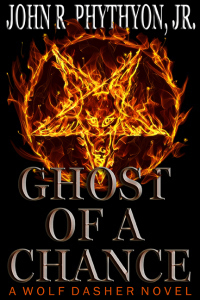John R. Phythyon Jr.'s Blog, page 12
October 21, 2014
Multiple Projects Update
Last week, I noted I was going to be taking on a new project while trying to keep going on the others. Here’s a little update on where several different books are in their developmental process.
“Secret Identity: My True-Life Adventure as a Superhero” is on pace for a November 3 release. I’ve got the final draft written, and I’m working on the layout now. I’ve sent ARC’s to a number of readers in an effort to create a strong review presence early in the book’s life.
Meanwhile, Jill is hunting down art for the cover. Hopefully, we’ll have a cover for this one I can show you very soon.
“Naughty & Nice: My True Life Adventure with Santa Claus” has made it through two drafts. I’ve sent it to my editor for her first look at it. I should have it back soon, and I hope to have a third draft completed by early next week. This one is scheduled for December 1, so it too is on-pace, but there remains a lot to be done with it.
The website needs a new page. I’ll be creating a “Memoirs” page in the next day or two, and that’s where all the information on the True-Life Adventure series will go. That should be done by the end of the week.
The title of the book I’m writing for Amazon’s Kindle Scout program is Little Red Riding Hoodie: A Modern Fairy Tale. My stepdaughter gave me the name, and it’s a revamping of a novel I penned 11 years ago called Little Girl Lost. I’ve had to make some significant changes to the plot, and to put it kindly, I’m a much better writer than I was back then. Thus, while I have made use of good chunks of the old novel, the text has needed a lot of massaging and shaping.
Consequently, I’m a little off the pace of where I want to be with it. To have a chance of making deadline with this project, I’ve set a goal of 5000 words a day. As of this morning, I had 20,437. Thus, I’m averaging about 4000 words a day. I need to pick it up a little here.
Finally, I’m authoring a story to submit to a forthcoming collection of holiday-themed shorts. This tale, “An Unexpected Blessing”, made it through the first draft. I’ve edited that and decided I need to move events around a bit to make it read better. The deadline for that story is November 21, so I’ve pushed the rewrite back to next week, so I can focus on Little Red Riding Hoodie this week.
Okay, that’s enough writing about writing. I need to get back to work on the manuscripts that are due. More news as it develops.
Filed under: e-Publishing, Writing Tagged: John Phythyon, writing


October 16, 2014
Ambition
I was scheduled to write the fifth part of my ongoing series on how I write a book today, but I’m putting it off until next week, because I have something else I want to write about. I’ll get back to The Process next week.
I’ve always been an ambitious guy. I reach for the stars on a regular basis. I believe in myself, and I’ve spent most of my life trying to figure out how to get the rest of the world to come along for the ride.
One of the things I’ve learned in the past ten years or so is to try to answer the door when opportunity comes knocking. While I endeavor not to live in regret, I once turned down a job offer in another city, because it wasn’t the right amount of money for my family. There was upward mobility potential, but the short term would have been hard.
The guy they hired after I decided not to take the job became a vice president at the company and made a metric ton of money as a result.
I don’t know if that would have been the right move for me or not. I prefer being a creative, and working for a financial services company probably wouldn’t have satisfied me in the long term.
But that doesn’t change the lesson. When opportunity knocks, you need to go see who’s at the door.
I currently hear a knock.
Amazon is offering a new program to its authors, wherein they’ll pay an advance and a decent royalty for a two-year contract on a previously unpublished book. You’ve got 45 days to submit.
I don’t have one ready to go. But I’ve got 45 days.
I’ve found an old manuscript that needs a pretty serious rewrite. But it has the skeleton and some of the muscle of a good novel. I don’t know if I can get it into shape in time. I don’t know if I’ll be accepted if I do.
But I’m going to try.
I could use the extra exposure. I could certainly use the advance.
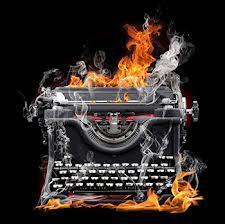 But it’s going to mean a lot of work. As a result of taking on this project, I am officially writing three books at once. Ordinarily, I stack projects, writing one while another is in editing.
But it’s going to mean a lot of work. As a result of taking on this project, I am officially writing three books at once. Ordinarily, I stack projects, writing one while another is in editing.
Right now, though, I’m writing the second draft of my second mini-memoir due out December 1. I’m writing the first draft of a short story for an anthology that is also scheduled to release on December 1. And I’m engaged in that rewrite. To have a shot at getting it ready in time, I need to write 5000 words a day on that book alone.
It’s an ambitious schedule. But I’m an ambitious guy.
I may need to blog a little less to make this happen. I’d been trying to blog on the Bengals twice a week and here twice a week. One of the Bengals ones is going to have to go, I think, and I may need to sacrifice one here. We’ll see.
But I can do this. I have the ambition, and I have the resolve. Opportunity’s knocking.
I’m on my way to the door.
Filed under: e-Publishing, Writing Tagged: ambition, opportunity, writing


October 14, 2014
Amazon Change Ill-Timed
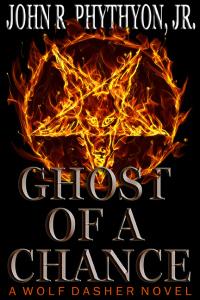 Good news! Ghost of a Chance released yesterday.
Good news! Ghost of a Chance released yesterday.
Then the bad news started to come in. I ended up in the hospital yesterday afternoon after severe pain in my lower abdomen convinced my doctor I needed to be seen for possible appendicitis. I spent most of the day both in pain and being treated. Everything came back negative, and they don’t really know what was wrong. I feel better today but am not well yet. That would be, if you’ll excuse the pun, painful enough.
But there was another major problem I didn’t discover until I got home last night.
I am running a free event for State of Grace to help boost the whole Wolf Dasher line with GoaC’s release. I put notes in the description of SoG directing people to the newly released GoaC and in GoaC’s description letting readers know they could get the first book in the series for free. I also bought several ads to push SoG as free.
As I lay on the hospital bed, I couldn’t understand why the response to the free event was so weak. Advertisers that had gotten me thousands of downloads in the past netted barely 300.
At home, I discovered Amazon had decided to make a little change. You see, I offer “The Darkline Protocol” as a free Wolf Dasher short story that is outside the main story arc. I therefore label it as Volume 0 through Amazon.
Yesterday, Amazon changed it to read that it is Book 1 in the series, and therefore changed State of Grace to Book 2. I checked my dashboard. I did not make these changes. It was Amazon.
So I tried to give away the second book in a series. You know, something new readers don’t want. They want to start from the beginning.
My free event tanked, which means my book launch also tanked. It’s difficult being a struggling indie author. It’s hard to find places that will advertise your books, especially new releases, and State of Grace is my most well reviewed book, making it the one I can most reliably get placed with the major advertisers.
I called Amazon customer service. A nice young man listened attentively, validated my concerns, but couldn’t help me at all. He took notes and forwarded it all up the chain.

STATE OF GRACE is Book 1, not Book 2 in the Wolf Dasher series.
I got an email this morning telling me to go in and manually change it. The problem is, the books still show on their editing pages as their proper volume numbers. I republished “Darkline” just to see if it would work, but it didn’t.
So I have to call Amazon again today and try to get something done. I’ll blog about my results when I have them.
In the meantime, if you don’t know the Wolf Dasher series but might be interested, State of Grace is Book 1, not Book 2. It’s free today, if you want to check it out at no risk. Get it here.
Filed under: e-Publishing, Ghost of a Chance, State of Grace Tagged: Amazon, ePublishing, KDP, Kindle


October 13, 2014
GHOST OF A CHANCE On Sale!
Yay! It’s finally here. After an arduous cross-country move, five edits on the longest book I’ve ever written, and two computer deaths — one the week before I was scheduled to publish, Ghost of a Chance, the fourth Wolf Dasher novel is available!
Naturally, I’m very pleased. It’s been a long journey on this one — especially since there was a physical journey happening concurrently.
The Kindle edition is available now. The print edition will be available in a day or so. I’ll make an announcement as soon as it is.
In the interim, here’s the link so you can get it. It’s available for the introductory price of only 99 cents!
Missing in action . . . Wolf Dasher has disappeared. The last anyone saw of him, he was pursuing master assassin Dexter Rose over the walls of Al-Adan and out into the wilderness beyond.
Wolf Dasher has disappeared. The last anyone saw of him, he was pursuing master assassin Dexter Rose over the walls of Al-Adan and out into the wilderness beyond.
But trouble hasn’t quit brewing in Alfar in his absence. Wolf may have saved the president from certain death, but the genocidal Freedom Patrol is soaking the city in blood in its mad quest for religious purity and the release of its polarizing figurehead, Mother Gladheart, from government custody.
Meanwhile, the sinister terrorist organization, the Sons of Frey, is defiling sacred shrines all over Al-Adan in a precursor to unleashing Hell on Alfar. The entirety of elfkind teeters on the brink of Armageddon.
Even if Wolf Dasher is alive and found in time, is he enough to stand against the forces of darkness – the fabled Tohgmaroch prophesied to defeat a demon and lead the people to a new golden age? Or is he destined only to die at the hands of those who would destroy everything in their desire for conquest?
Ghost of a Chance is the biggest Wolf Dasher thriller of them all. The stakes have never been higher and the odds never more desperate as the fate of all elves hangs in the balance. Epic fantasy collides with espionage and horror in this exciting genre-mash-up novel. A tale of heroism and love in the face of grief, loss, terror, and madness, Ghost of a Chance is a deeply complex story that’ll keep you turning pages until the apocalyptic end!
Click here to purchase Ghost of a Chance from Amazon.com!
Filed under: Ghost of a Chance Tagged: ePublishing, Ghost of a Chance, JohnPhythyon, Wolf Dasher


October 9, 2014
How I Write a Book — Fourth Draft
Continuing my series on my process of bringing a book from my imagination to publication, I look this week at the fourth draft. To some of you, I may seem insane at this point. “Are you serious, Phythyon?” you might be asking. “After all this, you’re going to write another draft?”
Yes, I am. I’m a very methodical writer, and my editor has a deliberate process. We’ve both worked in newspapers, so we can churn out good material in only a draft or two on deadline.
But I’m trying to write something more enduring than a theater review or a performer profile for the features section. And I find the more I shape and craft a manuscript, the better it becomes.
Big Changes
 This is the second time my editor has read the manuscript. The first time, she was getting the story down, making grammatical corrections and a few major observations. Now that she knows what happens, she really digs into it.
This is the second time my editor has read the manuscript. The first time, she was getting the story down, making grammatical corrections and a few major observations. Now that she knows what happens, she really digs into it.
Last week, I discussed how she asks probing questions about the way things work. In this edit, she is really looking for things that don’t make sense. She continues to correct my grammar and tighten my prose, but at this stage, she is trying to blow it up. She looks for the hole you could drive a semi through — or even a Volkswagen Beetle.
I get a lot more questions in the margins when the third draft comes back to me. I am asked to justify what I am doing a lot more frequently.
Just as I do with the other drafts, I read the whole book again, reading the notes and corrections in context. This is the most careful reading I give an edited draft. Only the first draft gets examined more closely. Just as my editor is searching for problems in the structure, so am I.
There are two reasons for this. First, I know that she is looking to break things apart, so I want to be in that hyper-critical mode too. I want to be thinking like her, so I can understand what she thinks needs adjusting, and so that I can catch anything she might not have.
Second, this is the last chance I’m going to get to make substantive changes to the novel. By the time we get to the next phase, we’re not looking to rewrite the book. We’re just trying to catch mistakes and tighten the prose. The final drafts are all about polish.
So this is the last time to make alterations that will change the story or the pacing or characters. I need to make sure I don’t miss any opportunities to make it a better novel.
One Last Rewrite
With all my notes and those of my editor, I sit down at the computer again. It’s time for that final rewrite.
I treat this draft of the novel the same way I have the others. I read the book again, going through it line by line and making changes according to the notes. Whole paragraphs can be cut or added at this stage. I don’t recall ever adding a new chapter at this stage, but I have tacked on significant sections. It’s rare, but I have also moved scenes and chapters around at this stage, deciding that the pacing will be better if the events happen in a different sequence.
By the time I’m done with the fourth draft, I really know the story. In some ways, I’m growing sick of it. For me at least, writing a novel means living with it for several months. It is an intense and intimate process, and it requires me to have the book at the forefront of my mind for a long time.
The good news is, once I have the fourth draft written, I am getting very close to publication. There is one more draft to be penned, but it is created in an entirely different way than the others.
I’ll talk about the fifth draft and its unique process next week.
Filed under: e-Publishing, Writing Tagged: indie, John Phythyon, writing


October 7, 2014
TWIN PEAKS A Huge Influence on my Work
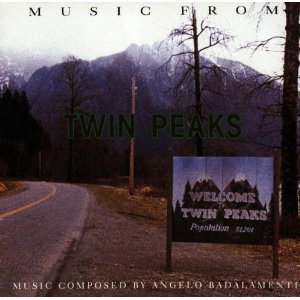 If you were living under an internet rock yesterday, you might have missed one of the day’s most pop-culturally significant announcements — Twin Peaks will be back on the air. Showtime is bringing a new, nine-episode season of the sensational Mark Frost-David Lynch show to television in 2016.
If you were living under an internet rock yesterday, you might have missed one of the day’s most pop-culturally significant announcements — Twin Peaks will be back on the air. Showtime is bringing a new, nine-episode season of the sensational Mark Frost-David Lynch show to television in 2016.
Yes, I know that’s at least a year-and-a-half, if not two years, away. Why is everyone so excited about something that’s going to happen so far in the future?
Because even 23 years after it went off for the last time, Twin Peaks is still thought to be one of the greatest shows in the history of television. Strange, surreal, quirky, funny, and frightening, it was compelling TV for most of its short, 30-episode run from 1990-91. (There was a period in the middle of its second season, where you really wondered where it was going.)
“Peaks” has a legion of obsessive fans, and I am one of them. I watched the show almost from the beginning. I missed the pilot when it originally aired, but I was watching faithfully from Episode 2 on. When it was released on VHS, I saved my money to buy the tapes one at a time until I had the whole show. I bought the first season when it came out on DVD, and I got the Gold Box Edition for Christmas the year it came out. (I am hoping for a similar arrangement this Christmas with the Blu-Ray collection.)
I saw Twin Peaks: Fire Walk With Me in the theater. I was one of the few people who liked it. I hunted down secondhand copies of The Secret Diary of Laura Palmer, Dale Cooper: My Life, My Tapes, and Welcome to Twin Peaks. I own Full of Secrets, a collection of scholarly essays on the show. I’ve got the complete set of collector cards.
Twin Peaks found me at a pivotal moment in my life. I was just finishing college, and right after it ended, I went to graduate school. The strange, otherworldliness of the show captivated my young scholar’s brain. The way Lynch played with nonlinear time in the movie fascinated me. The magic of the Black Lodge ensorcelled me.
The influence of Twin Peaks on my work as an artist is difficult to understate. In 1999, I published Heaven & Earth: A Role-Playing Game of Fate and Destiny. This experimental RPG from my early days in the hobby games industry has Peaks fingerprints all over it. I was very deliberately trying to emulate Lynchian surrealism in the game, and its official setting, Potter’s Lake, drew heavily from the mood and atmosphere of Twin Peaks.
The climactic scenes of the novels I published last year both show strong influences from the show. In The Sword and the Sorcerer, Calibot’s journey into his father’s tower towards the end of the book is a surreal carnival that is reminiscent of Laura’s Palmer’s strange trip inside the picture Mrs. Chalfont gives her in the movie and Dale Cooper’s entry into the Black Lodge in the series’ climactic episode.
In Beauty & the Beast: A Modern Fairy Tale, Caleb’s transformation into Beast over the course of the book invokes images of Leland Palmer’s possession by BOB. The final metamorphosis has the same kind of horror as Maddie’s murder on the show.
Even as recently as my newest book, Ghost of Chance, which releases October 13 and is a James Bond-fantasy mash-up, I include elements of Twin Peaks. Wolf is given three mysteries to solve by an otherworldly source, just as Cooper was. As a crime is being committed, he is told, “It is happening again.”
I can’t emphasize enough how important Twin Peaks is to me as an artist. Its long-form storytelling and skillful blend of magic and modernity, quirky and quaint, has guided my own creative decisions for nearly 20 years. The prospect of it being back, of it being written, produced, and directed by Frost and Lynch, and of it being on a pay channel like Showtime, so they won’t have any of the creative restraints of broadcast television like they did when it aired on ABC is just about the most amazing news I’ve heard in a long time.
I have often wondered what Frost and Lynch could have done with Twin Peaks if they had been able to make shows like you find on HBO and Showtime today. Soon, I’m going to get to find out.
I can’t wait to see what they do . . . and how they’ll influence me next.
Filed under: Why I Write Fantasy Literature, Writing Tagged: David Lynch, Mark Frost, Showtime, Twin Peaks


October 3, 2014
How I Write a Book — Third Draft
Continuing my series on my process for writing a book, today I examine my approach to the third draft. When I’m finished with this version of the manuscript, I’ll be about halfway done with the book.
“What?” you say. “How many drafts do you write, Phythyon?”
It depends on the book, but the average is five. And there are steps after that fifth draft too. More on those in future blogs.
 In the meantime, the third draft is one of the scariest for me. This is the first time I view feedback from an outside source. Here’s where I find out if my editor hates or thinks it is really good or something in between. So far, she’s never hated one, but writer’s suffer from crushing self-doubt, so getting the MS back is always frightening.
In the meantime, the third draft is one of the scariest for me. This is the first time I view feedback from an outside source. Here’s where I find out if my editor hates or thinks it is really good or something in between. So far, she’s never hated one, but writer’s suffer from crushing self-doubt, so getting the MS back is always frightening.
Raising Questions
As I mentioned last week, I send the completed second draft to my editor. She reads the entire book, making editorial notes as she goes. Most of the corrections she makes are for grammar. She finds typos, bad usage, clunky sentences, and such. Most of the time she suggests a change, but sometimes, she just writes, “awkward,” in the margin, and I have to figure out how to fix it myself.
She also asks questions if she doesn’t understand something about the setting. This is one of the most useful things she does in the entire process. Aside from being a Harry Potter fan (like pretty much the rest of the world), she doesn’t really read a lot of fantasy literature. I find that to be a real benefit, because she isn’t immersed in fantasy tropes, archetypes, and styles. She doesn’t accept what I put in there because it’s standard fantasy fare. She makes me justify it.
That’s good, because I am trying very much not to be a standard fantasy guy. I like writing about elves and dragons and wizards, but I don’t like faux archaic language, passive voice, and cliched storylines. I don’t want to rehash Tolkien. I write in a contemporary vernacular, and I blend modern sensibilities with classical swords-and-sorcery settings.
Even then, I miss things. I make assumptions based on archetypes that more casual readers of fantasy literature (or thrillers for the Wolf Dasher series) might not recognize. She points them out and makes me think about if they need better articulation.
She also thinks of details that don’t occur to me. For instance, in her first reading of The Sword and the Sorcerer, she asked me about magic. In the opening scene, a wizard’s spell emits purple energy from his wand.
“Is all magic purple,” she asked.
I didn’t know the answer to that. I just described that spell as purple, because that’s how I saw it in my head.
But I realized I needed to know. So I went through the manuscript and looked at every spell to see what color the magic was. I got the idea that spells should be color-coded based on what they did, and I developed an internal logic for that novel on what each should be.
That influenced my thinking for all subsequent books, even ones that had nothing to do with The Sword and the Sorcerer. For example, towards the end of the third Wolf Dasher book, Roses Are White, the villain casts a spell that transforms the ground into a giant hand of earth. I decided that transformative magic was yellow, and the ray from the wizard’s wand was therefore yellow. In the next book, Ghost of a Chance (which goes on sale Monday, October 13, by the way), another magician turns a crossbow into a dove. Remembering the basic idea that sorcery that changes something’s essential nature is yellow, I made sure it was a yellow beam striking the crossbow. Later in the book, when he turns a cart into a flock of sparrows, the magic is yellow again.
This sort of internal consistency is important for a well crafted narrative. If the details remain the same from scene to scene and novel to novel, readers accept and appreciate the world much better. They trust the author to deliver a solid book that meets expectations.
This is one of the crucial things I rely on my editor for. I’d never thought about color imagery in magic until she asked if it meant anything. She sees things (or the lack of things) I don’t, and she asks questions. That makes me a better writer.
A Thorough Reading
Despite the fact that my manuscripts generally come back with lots of notes on them, I don’t just got through looking for her changes and making them. I could improve the book that way, but I don’t feel it’s good enough.
Instead, I sit down with the manuscript and read it cover to cover again. With a blue pen in hand (so I can distinguish my marks from my editor’s), I read every word, making my own notes. I often make the changes my editor suggests in pen on the page before I go into my computer to change them in the master copy.
I do this for a couple of reasons. First, as I alluded to last week, I don’t really know the story until I’ve read it. This is essentially my second reading of the book — the one where I really start to notice how it fits together and and how the themes and plots play out. Before I can make changes, I want to understand what I’ve written.
Second, for me to understand my editor’s request changes, I have to see how they fit into the overall narrative. Does it matter if magic is color-coded? I need to read the book to decide. I want my head in the scene, when I read her comments. That way, they make better sense to me.
Rewriting
After I’ve read the book and the edits, I sit down at the computer and go through and put them in. At this stage, many of the changes I make are cosmetic. Like I said, the first edit is largely for grammar and very big picture stuff. I wish she would edit the book structurally at this stage, because it’s easier to make changes to a book earlier than later. But she has her own process too, and I have to respect it if I want good results.
So after I’ve read the book, examined her edits, put them in as appropriate, and essentially tuned up the manuscript, I’ve got a third draft ready to go. Ready to go where? Back to my editor. That’s where she’ll really dig into the story, and look for things that need changing.
And that’s what I’ll explore next week.
Filed under: e-Publishing, Writing Tagged: indie, John Phythyon, writing


September 30, 2014
GHOST OF A CHANCE Cover Reveal
Things are accelerating nicely with the new Wolf Dasher thriller, Ghost of a Chance! We finished the final edit over the weekend, and the print edition is now under review with CreateSpace.
And that means, I’ve got a cover to show you! Check it out:
I also just got the description done too. For those of you wanting a hint of the action, here you go:
Missing in action . . .
Wolf Dasher has disappeared. The last anyone saw of him, he was pursuing master assassin Dexter Rose over the walls of Al-Adan and out into the wilderness beyond.
But trouble hasn’t quit brewing in Alfar in his absence. Wolf may have saved the president from certain death, but the genocidal Freedom Patrol is soaking the city in blood in its mad quest for religious purity and the release of its polarizing figurehead, Mother Gladheart, from government custody.
Meanwhile, the sinister terrorist organization, the Sons of Frey, is defiling sacred shrines all over Al-Adan in a precursor to unleashing Hell on Alfar. The entirety of elfkind teeters on the brink of Armageddon.
Even if Wolf Dasher is alive and found in time, is he enough to stand against the forces of darkness – the fabled Tohgmaroch prophesied to defeat a demon and lead the people to a new golden age? Or is he destined only to die at the hands of those who would destroy everything in their desire for conquest?
Ghost of a Chance is the biggest Wolf Dasher thriller of them all. The stakes have never been higher and the odds never more desperate as the fate of all elves hangs in the balance. Epic fantasy collides with espionage and horror in this exciting genre-mash-up novel. A tale of heroism and love in the face of grief, loss, terror, and madness, Ghost of a Chance is a deeply complex story that will keep you turning pages until the apocalyptic end!
There it is. I’ll have more updates over the next couple weeks. Advance Reader Copies will be available soon for those who want to review. Ghost of a Chance releases Monday, October, 13!
Filed under: e-Publishing, Ghost of a Chance Tagged: Ghost of a Chance, John Phythyon, Wolf Dasher


September 25, 2014
How I Write a Book — Second Draft
Last week, I began a series taking you inside my process for bringing a story from idea through to published novel. (Read the first installment, here if you missed it.) I’ll continue today by examining how I create my second draft.
What Did I Write?
I have a basic rule I follow when I’m penning the first draft of a novel (or really any piece): Just get it down.
I don’t worry too much about the quality of the writing on that first draft, nor am I overly concerned about structural problems in the manuscript. I have found that the hardest part of writing a book is finishing it. So when I’m involved in the actual creation process — the writing — I am only concerned with finishing. Get the ideas out of my head and into the computer.
Consequently, when I’m finished, I’m not sure exactly what I have. It might suck. It might have plot holes large enough to drive my pickup truck through. Characters might have changed in illogical ways from the start of the novel to the end.
Moreover, I’m not wholly sure what the story is. I don’t have a good sense of it. While I’m writing, I am hyper-focused on the small picture. I am looking at the book on a chapter-by-chapter, sentence-by-sentence basis.
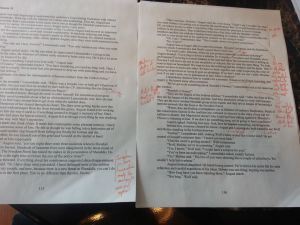
Notes in the manuscript for GHOST OF A CHANCE.
So the first thing I do with my first draft is read it. I print it out, because I find I see things better in print than on the computer screen, and I sit down with a red pen and read through the manuscript.
This is the most critical reading I give the book. Over the course of the writing process, I will end up reading it five or six times. But this is the most ruthless examination of the text I make.
Not only am I getting a grip on the narrative as a whole, I am looking for major problems. Occasionally, I’ll see a turn of phrase or a plot element I’m pretty proud of, but for the most part, I’m looking for mistakes and things that need improvement. I’m harder on myself than my editor is, because I want to write the best book I possibly can.
Tear It Apart
Reading the manuscript at this stage is a difficult exercise. It’s not that I’m upset with myself because I don’t think I did a good enough job. I am expecting flaws, because in the first draft, I was just trying to get it down instead of worrying about structure or craft. That’s that the subsequent drafts are for.
The issue is that identifying a problem isn’t enough. I have to come up with a solution.
One of the most common changes I make between drafts 1 and 2 is shifting the order of events. Whole chapters move from one place in the book to others. Sometimes events are taken out of one chapter and placed in another. That changes chapter length, so then I have to look and see if a chapter is too long or too short. In general, 1500 words is what I feel is the minimum length for a good chapter. I will write shorter ones towards the end, to keep the reader turning pages, but for the bulk of the narrative, anything less than 1500 words doesn’t feel like a chapter to me.
Likewise, I don’t like my chapters to run longer than 4000 words. Even when I am writing a traditional fantasy, I model the thriller format heavily. I want the reader getting caught up in the story and feeling they can’t put the book down. Longer chapters tend to bog down the narrative and slow the action. So I don’t want things running on too long. Shorter chapters with cliffhanger endings encourage more page-turning.
I also look for plot holes and other inconsistencies. I rarely make wholesale changes to the plot, but I have been known to eliminate, alter, or add important scenes. I am constantly asking myself the questions, “Does this make sense?” and “Is this plausible?” If it can’t pass my own logic test, it has to change.
Getting Ready Again
With the manuscript read and marked up, it’s time for me to outline again. Fortunately, I don’t have to plot as extensively as I did for the first draft. But since it’s very likely I will be moving scenes and chapters around, I need a map for how to do it.
I therefore get out my notebook again and draft a new chapter order. If necessary (and it often is), I summarize which scenes are going where.
If I have to add something new, I outline that as well, just as I would have in the first draft. This is especially important, because new scenes are the result of me seeing something missing. Every added scene has a critical role to play in smoothing out the narrative and making it read better. This, I have to execute them correctly, and as I mentioned last week, I am a Plotter.
Rewrite
With all that preliminary work done, it’s time to start the rewrite. Obviously, this goes a little faster than the original draft, since I already have most of the words in front of me.
However, it is still a slow process. An effective rewrite, especially one where I am making large changes or reorganizing the material, requires me to have my head deep in the manuscript again. So I put that marked-up first draft in front of me and read it again. Every time I come across an editorial note, I stop and make a change in the electronic version. If my outline calls for me to move something, I do. If I am supposed to add a scene, I refer to my plan and write it.
I do pay attention to my sentence structure at this point, trying to improve on phrases and cutting unnecessary words as often as possible, but that’s not really my focus at this stage. Right now, I’m really concentrating on organizing the novel, so that I have a well structured story that reads well and is entertaining.
By the time I’m done, the book usually looks a lot different than the first draft. I’ve taken the time to really craft the structure of the story.
With the second draft finished, it’s time for the most terrifying part of the process — letting someone else read it. I send the book to my editor and wait on pins and needles to see what she thinks.
I’ll explore that stage next week, when I look at the third draft.
Filed under: Writing Tagged: indie, John Phythyon, writing


September 23, 2014
High School Prank Proves Racism Is Everywhere
Every now and then, an event comes along that explodes all our self-delusions — the myths we choose to believe about ourselves and our community.
Prior to moving to Ohio this summer, I lived for 23 years in Lawrence, Kansas. If you’re not familiar with Lawrence’s culture, it was the center of the Free State movement in Kansas in the 1850’s. It helped drive Kansas’s choice to enter the union as a Free State on the eve of the Civil War in 1861. It was burned to the ground by William Quantrill and his Missouri Roughriders in 1863 as a result of its pro-Abolition politics. It was very much at the center of Bleeding Kansas in the 19th Century.
And the city is fiercely proud of this heritage. The citizens of Lawrence wear their place in history like a badge of honor.
These days, Kansas is one of the reddest of red states, but Lawrence is a liberal stronghold. It is a tiny pinprick of progressivism in a sea of conservatives. Lawrence is equally proud of this status. It revels in spitting in the eye of the rest of Kansas. And the loathing Lawrencians feel for those outside Douglas County is returned with relish by the rest of the state. If you want to have your ideas dismissed out of hand, tell someone who is not you are from Lawrence or vice versa.
Collectively, Lawrence believes it exemplifies post-racist America, a shining beacon of the way things ought to be.
But maybe not.
Lawrence has two high schools — the older Lawrence High and newer, more modern Free State High School (there’s that Abolitionist pride again). LHS is in central Lawrence; Free State sits on the northwestern edge of town in one of the most affluent regions of town. Despite the school district’s attempts to draw the boundaries so that there isn’t a “rich school” and a “poor school,” most of the lower-income students attend LHS.
I lived in the Free State district, but my daughter listed her official address as her mother’s and therefore attended Lawrence High. She could have gone to either, since her mom and I split time with her. She chose LHS, because that’s where most of her friends went.
As you might expect, LHS and Free State have a pretty intense rivalry. It has all the classic elements of two schools across town from each other competing for who is the best at anything, especially (but not limited to) sports. Free State has been on a win streak in football, which frustrates the LHS students to no end, while Lawrence High tends to win more of the basketball games. The two schools are balanced enough that the rivalry isn’t one-sided, which feeds its intensity.
Recently, however, the competition between the two Lawrence high schools has turned from spirited to ugly. Last year during the Free State-LHS basketball game, a number of Free State kids held up signs that read, “Ballin’ on a Budget.” My daughter and her friends were asked by Free State students, if they needed free or reduced-price lunches.
Apparently, innocuous claims like “Firebirds rule!” or “Lions suck!” were no longer good enough to assert Free State’s superiority over their cross-town rivals. Now, a certain group of students felt it was necessary to deride LHS students for being poor. As though that is some sort of a crime. As if it makes them less worthwhile as human beings.
But as demeaning and inappropriate as that was, it didn’t seem to be enough for some Free State students. Some of them decided to up the ante.
Last week, prior to the annual football game between the two schools, some students broke into the LHS football stadium and used shaving cream to write, “School of [N-word]s,” on the 50-yard-line. Not coincidentally, LHS has a much larger percentage of black students than Free State.
Yes. In proudly liberal Lawrence, some students from the school named for the Abolition movement hurled an N-bomb at their rivals.
Naturally, some LHS students retaliated. They wrote, “School of Crackers,” on the side of a Free State bus in spray paint. Hatred begets hatred. Bigotry begets bigotry.
This is what I mean when I suggest we are not living in a post-racist America. Yes, things are better than in the 1860’s or the 1950’s. Yes, we have moved a long way towards a more egalitarian society.
But we’re not over racism in the U.S. It’s not just in the South, where everyone assumes it is. It’s not just in the hearts of disgraced former NBA owners like Donald Sterling.
It’s everywhere.
It’s just as likely to be found in liberal outposts like Lawrence as it anywhere else in America.
Those students , whoever they are, believe LHS is inferior because it has a lot of poor and a lot of black students. They make fun of Lawrence High not because it’s their rival school, but because of the makeup of its student body.
Racism is an ugly legacy on both human and U.S. history, and despite all the battles fought and victories won during the Civil Rights movement, the war against it is not over. Because you can enact laws and call bigotry wrong and identify it for all to see and revile.
But none of that matters if you don’t change people’s hearts. If we don’t acknowledge we still have a problem in the U.S., that racism still exists and must still be fought, we can’t stop it from spreading. We can’t stop it from thriving.
Even in places that take pride in their history of fighting it.
Filed under: Current Events Tagged: Free State High School, Lawrence High School, Lawrence Kansas, Racism



